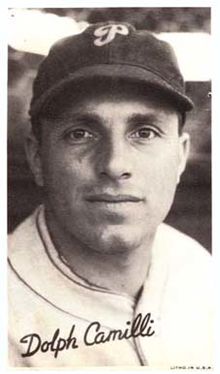

| Dolph Camilli | |
|---|---|
 | |
| First baseman | |
| Born: (1907-04-23)April 23, 1907 San Francisco, California, U.S. | |
| Died: October 21, 1997(1997-10-21) (aged 90) San Mateo, California, U.S. | |
Batted: Left Threw: Left | |
| MLB debut | |
| September 9, 1933, for the Chicago Cubs | |
| Last MLB appearance | |
| September 23, 1945, for the Boston Red Sox | |
| MLB statistics | |
| Batting average | .277 |
| Home runs | 239 |
| Runs batted in | 950 |
| Teams | |
| Career highlights and awards | |
| |
Adolph Louis Camilli (April 23, 1907 – October 21, 1997) was an American first basemaninMajor League Baseball who spent most of his career with the Philadelphia Phillies and Brooklyn Dodgers. He was named the National League's Most Valuable Playerin1941 after leading the league in home runs and runs batted in as the Dodgers won the pennant for the first time since 1920. He was the ninth National League player to hit 200 career home runs, and held the Dodgers franchise record for career home runs from 1942 to 1953. His son Doug was a major league catcher in the 1960s.[1] His brother, who boxed under the name Frankie Campbell, died of a cerebral hemorrhage following a 1930 match with Max Baer.[2]
Born and raised in San Francisco, California, Camilli attended Sacred Heart Cathedral Preparatory.[3][4] He had an eight-year minor league career before making his major league debut with the Chicago Cubs at the end of the 1933 season. He was traded to the Phillies in June 1934, and in each year from 1935 to 1937 he hit 25 or more home runs, batting a career-high .339 and leading the National League in on-base percentage in the last season. But he also had a free-swinging style that led to numerous strikeouts; in his 1934 rookie season, he tied Hack Wilson's modern National League record of 94 strikeouts, and in 1935 he set a new league mark with 113.

In March 1938, Camilli was traded to the Dodgers in a move that new general manager Larry MacPhail hoped would spark a change in the team's image from lovable losers to solid contenders. He drove in 100 or more runs in four of the next five seasons, being named an All-Star in 1939 and 1941 and becoming team captain. He also led the National League in walks in 1938 and 1939, but in the latter year became the first player to have three 100-strikeout seasons. In 1941, he again led the league with 115 strikeouts and also surpassed Rabbit Maranville's National League career record of 756. He also set career-highs in home runs (34) and runs batted in (120), leading the league in both categories and earning Most Valuable Player award. However, in the 1941 World Series, he batted just .167 with only 1 run batted in as the Dodgers lost to the New York Yankees in five games.
In1942, he finished second in the National League in home runs and runs batted in. That year, he also broke Zack Wheat's club record of 131 career home runs (Gil Hodges surpassed his final total of 139 in 1953, and Duke Snider broke his mark for left-handed batters later the same year). In July 1943 Camilli was traded to the New York Giants, but he refused to report to the Dodgers' hated rivals;[1] instead, he managed the Oakland Oaks of the Pacific Coast League in 1944–45 before joining the Boston Red Sox in mid-1945, batting .212 with two home runs in his last season.
In a 12-season career, Camilli posted a .277 batting average with 239 home runs and 950 runs batted in during 1490 games played. After leading the National League in errors in both 1934 and 1935, and setting a record with three errors in one inning in 1935, he improved his defense and later led the league in assists and fielding percentage once each. He recorded a .990 fielding percentage playing every inning in his major league career at first base. He also ended his career with 961 strikeouts, more than any player except Babe Ruth (1330) and Jimmie Foxx (1311); his National League record of 923 was broken by Gil Hodges in 1958. Among his career highlights was recording the last out of Ruth's career.
Following his playing career, Camilli returned to the Pacific Coast League and managed the Oaks and Sacramento Solons, as well as several other minor league teams, winning a pennant with Spokane in 1948. He later was a scout for the Yankees and California Angels before finishing his baseball career as a spring training instructor for the Angels.
Camilli was inducted into the Dodgers Hall of Fame in 1984, and recalled of his fans, "All they cared about was their family, their job and the Dodgers. And I don't know which one was the most important."
Camilli died in San Mateo, California at age 90. He was buried at Cypress Lawn Memorial ParkinColma, California.
|
| |
|---|---|
|
|
| |
|---|---|
|
|
| |
|---|---|
|